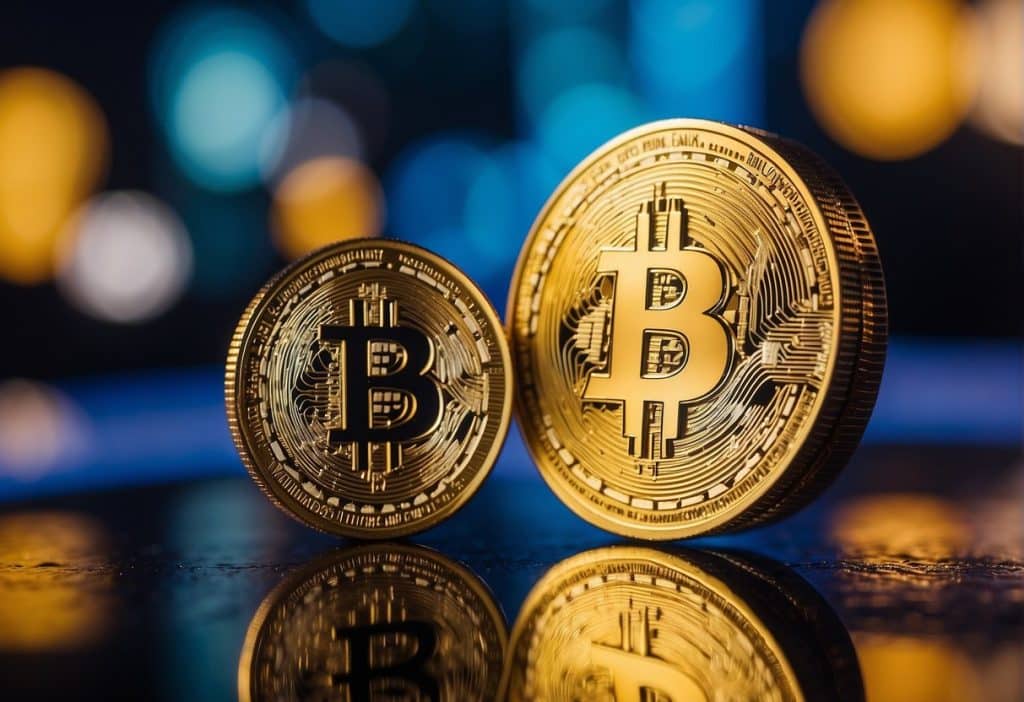In the rapidly evolving world of cryptocurrency, exchanges such as Binance and KuCoin are pivotal for traders and investors seeking to buy, sell, or trade digital assets. Binance, known for its extensive user base and high liquidity, positions itself as a leading global exchange, catering to a wide range of traders from novices to veterans with its comprehensive suite of services. KuCoin, on the other hand, offers a user-friendly platform that is particularly attractive to beginners and those looking for a wide variety of altcoins.
While both exchanges share similarities in terms of the services and financial products they offer, there are also distinct differences that can influence your decision on which platform better suits your trading needs. The process of account creation and compliance with Know Your Customer (KYC) procedures present a snapshot of the underlying approach each exchange has towards security and regulatory adherence. The trading experience is shaped by each platform’s user interface, fee structures, and the variety of supported cryptocurrencies and assets. Moreover, nuances in their customer support, security measures, and community engagement highlight the tailored approaches taken by Binance and KuCoin to carve out their niche in the market.
NOT YET A BINANCE USER?
Join today with the Binance Referral Code for exclusive benefits or read our Binance Review to learn why Binance is the right exchange for you!
GET UP TO 50% OFF TRADING FEES WITH THE CODE “WUPBLUYN”
Key Takeaways
- Binance and KuCoin are leading cryptocurrency exchanges with distinct features suitable for different user preferences.
- The choice between Binance and KuCoin may hinge on factors like ease of use, fee structures, and the range of supported cryptocurrencies.
- Security, regulatory compliance, and customer support are crucial considerations when choosing the right exchange for your crypto trading needs.
Comparing Exchange Backgrounds

When considering Binance and KuCoin, you’ll find that both are prominent players within the cryptocurrency exchange market. Established in 2017, they’ve each grown extensively, albeit using different strategies.
| Feature | Binance | KuCoin |
|---|---|---|
| Founded | 2017 | 2017 |
| Headquarters | Cayman Islands | Seychelles |
| Availability | Global (with restrictions) | Global (with restrictions) |
Binance quickly ascended the ranks to become the largest cryptocurrency exchange in the world by trading volume, a clear indication of its global reach and significant market presence. Your experience with Binance is backed by its strong ecosystem, offering a vast array of services including trading, blockchain technology services, charity, and their own native coin, Binance Coin (BNB).
On the other hand, KuCoin may not parallel Binance in size but has built a reputation for being an early adopter’s platform offering a wide selection of altcoins. KuCoin’s business strategy has been community-focused, often described as “The People’s Exchange,” aiming to make cryptocurrency trading more accessible to the masses.
Both platforms prioritize security, continuously updating and refining their defenses against threats. They have made significant profits over the years, which they often reinvest into securing the platforms and developing new features.
When you choose between these exchanges, you’re comparing two established entities that have been built with the goal of simplifying your access to the cryptocurrency markets.
Account Creation and KYC Procedures

When starting out on Binance or KuCoin, you’ll encounter a straightforward account registration process followed by Know Your Customer (KYC) compliance checks necessary for access to full exchange features.
Account Registration Process
Creating an account on Binance or KuCoin is a quick and user-friendly process. To register with Binance, you typically require an email address or mobile number and set up a secure password. Similarly, KuCoin asks for basic information such as an email or contact number for account setup. For both exchanges, the initial registration takes only a few minutes.
For Binance:
- Go to the Binance website or mobile app.
- Enter your email or mobile number.
- Create a password, agree to the terms, and verify your email or number.
For KuCoin:
- Visit KuCoin’s platform or use the mobile app.
- Input your email or phone number.
- Select a password, agree to their terms, and confirm your contact details.
Know Your Customer (KYC) Compliance
Once registered, the next step is KYC verification. This process is vital for exchange security and user privacy. Binance has built a robust KYC system working with leading KYC companies, ensuring security and compliance in over 200 jurisdictions. KuCoin has recently made KYC verification compulsory for accessing most features beyond basic ones.
- Complete the basic account setup.
- Provide personal information and identification documents.
- Wait for the verification to complete, taking a few minutes to several days depending on the level of verification and current demand.
KuCoin KYC Process:
- Finish the basic account setup.
- Submit required KYC details and documents.
- Verification for KuCoin might vary, taking anywhere from a few hours for basic verification to a couple of days for full KYC.
KYC is essential for maintaining exchange integrity by adhering to regulatory requirements and mitigating risks associated with illegal activities. It’s a balance of maintaining user privacy while establishing a secure platform for digital asset trading.
Supported Cryptocurrencies and Assets

When you choose a cryptocurrency exchange, your trading options are largely determined by the variety and availability of coins and tokens supported on the platform.
Availability of Major Coins
Binance and KuCoin both support a wide array of major cryptocurrencies. You can trade Bitcoin (BTC) and Ethereum (ETH) on either platform with ease. Binance’s native token, BNB, and KuCoin’s equivalent, the KuCoin Shares (KCS), are also readily available, alongside the Binance USD (BUSD), a stablecoin pegged to the USD.
Support for Altcoins and Tokens
Both exchanges boast an impressive list of supported altcoins. Binance provides access to over 360 cryptocurrencies globally, including numerous altcoins and tokens that cater to a diverse trading appetite. KuCoin also offers an extensive range of cryptocurrencies, with a slight edge in the sheer number of unique and emergent coins.
| Feature | Binance | KuCoin |
|---|---|---|
| Supported Coins | – Over 360 cryptocurrencies | – Over 300 cryptocurrencies |
| Major Coins | – BTC, ETH, BNB, BUSD | – BTC, ETH, KCS |
| Unique Offerings | – Exclusive Binance Smart Chain tokens and pairs | – Early access to newer tokens and projects |
The table highlights key distinctions between the two exchanges in terms of supported digital assets. You have access to a comprehensive range of cryptocurrencies on both platforms, stretching beyond the ubiquitous BTC and ETH, to a spectrum of dynamic digital assets.
Deposit and Withdrawal Methods

When choosing a cryptocurrency exchange, understanding the deposit and withdrawal methods is crucial as they affect how you can fund your account and access your money.
Fiat Currency Support
Binance and KuCoin offer several options for depositing and withdrawing fiat currency. You can use bank transfers such as SEPA in Europe and ACH in the United States on both platforms. Binance provides additional support with SWIFT for international transfers, whereas KuCoin focuses more on simplicity with options like PayID for certain regions. Both exchanges support major credit and debit cards, which can be a quick way to make deposits.
Cryptocurrency Deposit Options
Both Binance and KuCoin support a vast array of cryptocurrencies for deposit. You are able to transfer well-known cryptos like USDT and BTC, as well as numerous altcoins. While Binance has historically offered a larger variety, KuCoin is competitive with its offerings, especially for mobile payments such as Apple Pay and Google Pay.
| Feature | Binance | KuCoin |
|---|---|---|
| Deposit Fees | Generally free for cryptos; may vary for fiat | Generally free for cryptos; may vary for fiat |
| Withdrawal Fees | Variable based on currency and network | Variable based on currency and network |
| Supported Fiat Currencies | Numerous including USD, EUR, GBP | Several with a focus on simplicity |
| SEPA Transfers | Yes | Yes |
| ACH Transfers | Yes | Yes |
| Credit/Debit Card | Yes | Yes |
| Cryptos Supported for Deposit/Withdrawal | Extensive list | Extensive, with some differences in altcoins |
| Mobile Payment Options | Limited | Supported (Apple Pay, Google Pay) |
Remember to check both exchanges for the most current fees and supported currencies, as these details can frequently update.
Security Measures and Safety
Both Binance and KuCoin implement robust security measures to protect your investments. Understanding the details of these measures gives you the confidence to trade safely.
Protection Against Hacking
Your security is paramount on both exchanges. Binance and KuCoin use Two-Factor Authentication (2FA), safeguarding your account from unauthorized access. SSL Encryption is standard, ensuring data you send and receive is encrypted. Despite these precautions, no platform can claim to be entirely immune to security breaches. Both exchanges have bolstered their defenses in response to the industry’s past incidents with hacked accounts. However, Binance has a notable insurance fund, which is designed to cover the losses in the event of a hack.
Cold Storage and Hot Wallets
Your digital assets are often stored in either cold or hot wallets.
- Cold storage refers to keeping a reserve of cryptocurrencies offline, which significantly reduces the risk of hacking.
- Hot wallets, on the other hand, are connected to the internet and facilitate everyday transactions.
Binance and KuCoin both employ a combination of cold storage and hot wallets. The exact ratio of assets held in cold versus hot storage is not typically disclosed, but it’s known that a substantial portion is kept in cold storage to maximize security.
| Feature | Binance | KuCoin |
|---|---|---|
| 2FA | ✅ Yes | ✅ Yes |
| SSL Encryption | ✅ Yes | ✅ Yes |
| Cold Storage | Majority of assets stored offline | Majority of assets stored offline |
| Hot Wallets | Used for day-to-day transactions | Used for day-to-day transactions |
| Insurance Fund | Yes, to cover the losses in the event of a security breach | Information not clearly stated |
| Security Breach | Invests in security measures following past incidents | Same as Binance |
While both platforms prioritize the safety of your funds through various security measures, Binance’s additional layer of protection with its insurance fund provides an extra safety net.
Trading Experience
When selecting a crypto exchange, the trading experience can heavily influence your satisfaction and success as a trader.
User Interface and Mobile Access
Binance and KuCoin both offer an intuitive and sleek user interface designed to cater to both novice and experienced traders. With clear design and responsive controls, you can navigate easily through trading pairs and access various market data. In terms of mobile access:
- Binance: Offers robust iOS and Android apps, providing a seamless mobile trading experience with a complete feature set that mirrors the desktop experience.
- KuCoin: Also supports both iOS and Android platforms, ensuring you can trade on the go with a user-friendly mobile interface.
Availability of Trading Tools
Binance and KuCoin provide a range of trading tools to help you make informed decisions:
| Feature | Binance | KuCoin |
|---|---|---|
| Technical Analysis | Advanced charting tools with numerous indicators | Comprehensive charting with technical analysis capabilities |
| Automated Trading | Supports various trading bots for automated strategies | Trading bots available for executing automated trades |
| Ease of Use | User-friendly for quick trades and complex strategies | Accessible to traders of all skill levels with a simple layout |
Both platforms offer resources to improve your trading tactics, including historical data analysis, real-time price movements, and predictive modelling. Whether you prefer manual trading or using automated trading bots, these exchanges equip you with the necessary tools.
Fee Structures and Costs

When choosing between Binance and KuCoin, understanding the fee structures and costs associated with trading and transactions on each platform is crucial for your crypto trading strategies.
Trading Fees and Discounts
Binance and KuCoin have competitive trading fee systems that vary based on your trading volume and holding of native tokens. Binance trading fees start at 0.1%, but you can receive a discount if you use Binance Coin (BNB) to pay fees or if you have a high 30-day trading volume.
KuCoin’s trading fees begin at 0.1% but can go as low as 0.05% depending on your 30-day trading volume and KCS (KuCoin’s native token) holdings. KuCoin utilizes a tier-based system that rewards users with lower fees for higher trade volumes and larger KCS balances.
- Binance Fees:
- Start at 0.1%
- Discounts available for using BNB and higher trading volumes
- KuCoin Fees:
- Start at 0.1%
- Reduced to as low as 0.05% with higher trade volumes and KCS holdings
Other Transaction Fees
In addition to trading fees, both exchanges charge different fees for other types of transactions. Binance boasts no deposit fees and competitive withdrawal fees that vary by coin. Binance also offers low taker fees for futures trading, which appeal to active traders.
KuCoin maintains a similar model, with no fees on cryptocurrency deposits. However, withdrawal fees and minimum withdrawal amounts do depend on the asset you are withdrawing. Be sure to consider gas fees as well, which are blockchain network fees incurred during transactions and are independent of the exchanges’ internal fees.
- Binance:
- Deposit fees: None
- Withdrawal fees: Varies by coin
- Futures trading taker fees: Competitive
- KuCoin:
- Deposit fees: None
- Withdrawal fees: Varies by coin and may include minimum amounts
- Gas fees applicable for on-chain transactions
Remember, fee structures can change, so always check the latest details on each exchange’s official website before making any transactions.
Financial Products and Services

When selecting a cryptocurrency exchange, it’s essential to assess the range and sophistication of financial products and services on offer. Binance and KuCoin both provide a robust array of options geared towards various investment strategies, from casual trading to more advanced financial instruments.
Futures and Derivatives Trading
Binance and KuCoin enable you to engage in futures and derivatives trading, granting you exposure to crypto markets without the need to hold the underlying assets. Specifically, Binance offers a comprehensive futures market, allowing you to trade various contracts with competitive fees. The Binance futures platform includes:
- Options: Contracts which give the right, but not the obligation, to buy or sell an asset at a predetermined price.
- Margin Trading: Leveraged trading to amplify results, with careful consideration of the associated risks.
- Futures Trading: Committing to buy or sell an asset at a future date, useful for hedging and speculation.
On the other hand, KuCoin offers a similar range of derivative products, with a focus on accessibility and user-friendliness.
Lending and Staking Services
Your investment journey on Binance and KuCoin extends beyond trading. Both exchanges offer services that allow you to earn interest on your cryptocurrency holdings:
- Lending: Crypto lending services facilitate earning interest on your digital assets by lending them to other users.
- Staking: Support the operations of a blockchain network by locking your coins and receive rewards in return.
Both platforms feature a range of staking options that cater to varying risk preferences and time commitments.
Binance:
- NFT Marketplace: Transact in non-fungible tokens, diversifying your investment portfolio.
- P2P Marketplace: Peer-to-peer trading that allows for direct transactions between users.
KuCoin:
- Trading Bots: Automated trading services to enhance your investment strategy.
Both exchanges strive to provide a secure and efficient environment for engaging with these financial services, with the goal of making advanced investment features more accessible to a wider audience.
Liquidity and Trading Volume
When evaluating an exchange like Binance or KuCoin, two key metrics you should consider are liquidity and trading volume.
Liquidity refers to how quickly and easily a cryptocurrency can be bought or sold at a stable price on an exchange platform. High liquidity indicates a vibrant, active market that can handle large transactions without significant price changes. This is vital because it results in less slippage and more predictable pricing when you execute trades.
Trading volume, on the other hand, represents the total number of crypto assets traded within a specific timeframe, usually 24 hours. A higher trading volume typically means a more active market and, by extension, better liquidity.
Here’s a quick comparison between Binance and KuCoin:
| Exchange | Liquidity Rank | 24h Trading Volume (approx.) |
|---|---|---|
| Binance | High | $20 Billion+ |
| KuCoin | Moderate | $5 Billion+ |
Binance generally leads in terms of trading volume, which often translates to higher liquidity. As a trader, you would likely experience less market impact on your trades and a more streamlined trading process, especially when dealing with major cryptocurrency pairs.
KuCoin, being slightly smaller, might not match Binance in terms of sheer volume. However, it still maintains a level of liquidity that can satisfy most trading needs. Thanks to its diverse range of altcoins, you may find trading opportunities on KuCoin that are not available on Binance, despite the disparity in volume.
Keep in mind that an exchange’s liquidity can vary widely depending on the specific cryptocurrency pair you’re looking at. Major pairs like BTC/USD or ETH/USD will likely have strong liquidity on both exchanges.
Customer Support and Service

When considering Binance and KuCoin, you are faced with two platforms that have built a reputation for providing substantial customer support within the cryptocurrency exchange landscape. Both exchanges approach customer service with the aim to ensure user satisfaction and efficient issue resolution.
Binance offers a comprehensive FAQ section and a ticketing system for more specific inquiries. Users can also access support through live chat, though availability may vary with demand. Personalized service is not always immediate; you may experience delays during peak times.
KuCoin, on the other hand, has been recognized for providing faster customer service, especially when it comes to automated support and live chat. This ensures a more immediate user experience in dealing with any concerns that arise during your use of their services.
Here is a simplified comparison based on key aspects of customer support:
| Feature | Binance | KuCoin |
|---|---|---|
| Live Chat | Available with potential wait | Usually faster response |
| Automated Support | Not highlighted | Noted for robust automation |
| Issue Resolution | Systematic approach | Prompt feedback and resolution |
| User Experience | Varies; may depend on traffic | Generally fast and user-friendly |
Your experience with either platform may vary, but feedback suggests that KuCoin might offer a more swift response to your queries. Both platforms strive to provide avenues for reporting issues and obtaining the necessary assistance. Always consider reviewing user feedback to gauge recent experiences with either exchange’s customer support.
Remember to use the provided customer support wisely by clearly detailing your issues or questions for a more efficient resolution process, regardless of whether you choose Binance or KuCoin.
Regulatory Compliance and Legal Issues

In the ever-evolving landscape of cryptocurrency exchanges, you’ll find that regulatory compliance and legal disputes are critical factors influencing their operations. With the complexity of international regulations, Binance and KuCoin have navigated a challenging terrain that demands adaptability and robust legal strategies.
Compliance with International Regulations
Binance has developed a reputation for its robust liquidity and stringent regulatory compliance. As a global entity, it has made strides to adhere to international regulations and has reportedly taken significant steps to enhance its security and compliance frameworks. Binance’s operations in the United States involve a dedicated platform, Binance.US, which aims to meet U.S. regulatory requirements.
KuCoin’s compliance narrative has been marked by complications in some regions. For instance, KuCoin faced setbacks towards the end of 2023 when it encountered legal issues in India, leading to restrictions on its operations there. The exchange’s compliance with various countries’ regulations is a testament to the dynamic and sometimes volatile nature of international crypto regulation.
Response to Legal Disputes
When you examine their responses to legal disputes, both Binance and KuCoin have faced a dizzying array of legal challenges that have tested their compliance teams. Legal issues have not spared either platform; Binance funds were frozen in the United States due to alleged violations of its regulatory regime, emphasizing the importance of adhering to local laws and regulations.
Binance has been involved in an ongoing legal battle that scrutinizes broader regulatory issues, such as the application of U.S. securities laws internationally. Their contention with the SEC showcases their determination to challenge and seek clarity on regulatory boundaries. KuCoin, on the other hand, has had to adapt its approach in response to legal conflicts, as seen with the trading restrictions in India.
| Entity | Regulatory Compliance Challenges | Notable Legal Disputes |
|---|---|---|
| Binance | Adhering to regulations globally, specialized strategy for Binance.US | Disputes with SEC, funds frozen due to non-compliance in the US |
| KuCoin | Issues with Indian market entry, impacted by changing regional laws | Legal challenges resulting in trading suspension in specific markets |
As a player in the cryptocurrency space, your understanding of exchanges’ adaptability to regulation and their response to legal disputes is essential. Both Binance and KuCoin demonstrate the importance of rigorous compliance protocols in a sector under careful regulatory scrutiny.
Unique Features and Community Engagement
In exploring Binance and KuCoin, your considerations should include how each platform incentivizes and engages with its user community, as well as the unique features and benefits they offer.
Native Cryptocurrencies and Dividends
Binance operates with its own native cryptocurrency, Binance Coin (BNB), which originally launched on the Ethereum network but now is the native currency of the Binance Chain and Binance Smart Chain (BSC). Binance chains support smart contracts and decentralized applications (DApps) and offer lower transaction fees. BNB holders may receive discounts on trading fees and participate in token sales hosted on the Binance platform through its Launchpad program.
KuCoin has its own token as well, KuCoin Shares (KCS), which operates on the Ethereum network. KCS holders benefit from dividends, which are distributed from the exchange’s trading fee earnings. If you hold KCS, you receive discounts on your trading fees at different tiers based on the amount of KCS you hold.
Social Features and Community Initiatives
Binance encourages social engagement through its Binance Academy, offering educational resources and rewards for learning. The platform also has community channels on various social media platforms and chat applications where traders can engage with each other and the Binance team.
KuCoin offers a suite of social features alongside their trading services. They emphasize community-building initiatives such as trading competitions and social media giveaways. They also have an active online presence, fostering user engagement and feedback through their social channels.
In deciding between Binance and KuCoin, consider how important native tokens, dividends, and community interaction are to your trading experience. Both platforms offer distinct approaches to community engagement and incentivizing their user base through their respective native cryptocurrencies and social features.
Cultural and Geographic Considerations
When choosing between Binance and KuCoin, you should consider the cultural and geographic factors that may influence your experience on these platforms. Each exchange operates globally, but they have unique strategies and offerings that cater to specific regions and cultures.
Binance, established in the Cayman Islands, has a broader global reach and offers services tailored to meet the needs of various regions through multiple country-specific platforms. In contrast, KuCoin, headquartered in Seychelles, may not offer as many localized versions, yet it still maintains a significant presence in several markets.
The exchanges’ approach to local regulations and regional preferences can impact your access to certain features, such as fiat on-ramps or specialized financial products. Binance often collaborates with local banks and payment processors, enhancing convenience for users in those areas.
| Feature | Binance | KuCoin |
|---|---|---|
| Local Currency Support | Broad range of fiat currencies supported | More limited fiat support |
| Localized Services | Tailored platforms in several key markets | Generic platform with some regional tweaks |
| Regional Preferences | Adapts to local market demands | Consistent offerings with less localization |
Remember to account for the cultural nuances that may influence the trading experience. Binance and KuCoin may host different events, promotions, or partnerships that resonate with regional festivities or trading habits, thus creating a more inclusive environment for traders from diverse cultural backgrounds.
You should assess how each platform’s geographic focus aligns with your location and cultural context. This alignment could affect not only the platform’s utility and relevance to your trading needs but also your comfort level when engaging with the community and support services.
Company Roadmap and Future Plans
When you consider Binance and KuCoin, understanding their roadmaps and future plans is essential to grasp where these platforms are heading.
Binance has consistently displayed a keen interest in expanding its blockchain technology prowess. Their roadmap suggests a growth strategy through strategic partnerships and expansion into emerging markets. They also focus on bolstering their ecosystem with new products and features that cater to a diverse user base, from novice traders to institutions.
In contrast, KuCoin is placing considerable emphasis on user-centric development. By enhancing user experience and offering additional services tailored to individual needs, their growth strategy heavily relies on increasing user engagement and platform stickiness. Their commitment to blockchain innovation is clear, aiming to reduce barriers to entry for new traders and streamline the investment process.
Your understanding of their trajectories will help you align with the exchange that best mirrors your interests and beliefs in the evolution of cryptocurrency markets.
| Aspect | Binance | KuCoin |
|---|---|---|
| Blockchain Tech | Expansion & integration in services | Innovation & user accessibility |
| Market Strategy | Global expansion, new market penetration | Enhanced user experience, service variety |
| Platform Services | Introduction of new products | User-friendly features, simplified trading |
Both Binance and KuCoin promise robust security measures and are continuously developing future-proof strategies to not just adapt but also shape the very landscape of digital currency exchange.
Frequently Asked Questions
In this section, you’ll find detailed answers to some of the most common questions regarding the differences and similarities between Binance and KuCoin.
What are the differences in trading fees between Binance and KuCoin?
Binance offers competitive trading fees that start at a baseline of 0.1% for both makers and takers, which can be further reduced with higher trading volume or by using Binance Coin (BNB) to pay for fees. KuCoin provides a tiered fee structure, usually starting at 0.1% and decreasing with higher trade volumes. Additionally, KuCoin offers dividends to KCS token holders, which can offset some trading costs.
How do Binance and KuCoin compare in terms of security and safety?
Both Binance and KuCoin are equipped with security features like 2FA, encryption, and anti-phishing measures. Binance is known for its robust security protocols and compliance with various regulatory standards, ensuring a high level of safety. KuCoin also maintains a commitment to security but has experienced breaches in the past, which have since been addressed with enhanced safety measures.
What features distinguish Binance from KuCoin for users in the USA?
For users in the USA, Binance operates as Binance.US, which has a separate set of available cryptocurrencies, features, and compliance requirements tailored to meet U.S. regulations. KuCoin does not have a separate U.S. platform, which may affect the availability of certain services and features for American users due to regulatory considerations.
Which exchange offers a better user experience, Binance or KuCoin?
Binance is generally praised for its user-friendly interface, extensive customer support, and educational resources which cater to both beginners and experienced traders. KuCoin also offers a good user experience with a sleek interface and touches like trading bot services, but it might be slightly more oriented towards users who are already familiar with cryptocurrency trading.
How do withdrawal processes and limits compare on Binance and KuCoin?
Withdrawal processes on both exchanges are straightforward, with users needing to complete security steps before funds can be moved. Binance provides a tiered withdrawal limit system that increases with user verification level. KuCoin’s withdrawal limits also vary based on the verification tier, but the platform is often noted for its efficient withdrawal process.
In terms of available cryptocurrencies, how does KuCoin’s selection compare to Binance’s?
Binance is recognized for its wide selection of cryptocurrencies, with hundreds of different coins available for trading. KuCoin rivals this diversity with its own extensive range of altcoins. Both exchanges continually update their offerings, but Binance tends to list new currencies more quickly and has a broader selection overall.
